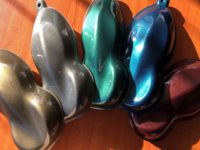
Industrial Painting Consultant
Friction-Reducing Coating
Reading your column is very enlightening. I saw a question from a reader [June issue] about reducing the friction between a boat hull and the water. There is such a coating. The coating is a flourourethane, developed jointly by the Naval Research Labs (NRL) and the Electric Power Research Institute (EPRI). The coating is hydrophobic, has a coefficient of friction slightly less than Teflon, and has been in use for about 20 years. The cost of the coating-$350 a gallon-has kept it relegated to specialty markets.
NRL coated the USS Hercules (a harbor boat, metal hull) in Chesapeake Bay as one test. The boat operated for 111/2 years without repainting but was retired for other reasons. Biofouling was removed with a fire hose because the barnacles could not stick tenaciously to the coating. After 111/2 years, there was no rust under the coating, and even where there were scratches, there was no rust migration under the coating.
When the coating was used on hydrofoil boats by NRL, no cleaning of the hulls was necessary because the water velocity over the hulls kept them clean of biofouling. Some applications of the coating may be classified. We have heard the Seal's ship-to-shore boats were coated with the fluorourethane coating to improve their speed, but it was not confirmed.
We are on the electric side of EPRI and took part in the development of the fluorourethane. The formulation has been modified to improve the coefficient of friction and is presently used by the electric utilities on their porcelain insulators to prevent contamination of the surface. It is also used on power-producing wind turbine blades as an ice release. Some areas of Palm Springs Wind Turbine farms use it to prevent insects from sticking to the blades and deteriorating the power output.
Thank you very much for your response, which brings considerable enlightenment on this topic. The very high cost of this coating was a surprise to me (although it probably should not have been). Perhaps some of our readers will want to explore other uses for this coating.
Cedar Siding Coating Problems
I am on the board of a cedar-sided condo complex. In 20 years, we have never had the siding finished, painted or treated. We recently did have all the siding cleaned, some of the more damaged siding replaced, and then had everything covered with a good coating of a semitransparent deck stain with no tint applied.
We had the new replacement siding tinted to match the newly cleaned siding, not realizing that within six months the older siding would quickly fade to gray, as seen in the photo I sent you. So we now have newer reddish siding looking patchy against the older gray siding.
We'd like to tint the stain reddish and then make another application over the original clear to make the surface look consistent and not patchy. However, our supplier has advised us that another application of its product will not adhere to the previous application without removal of the first, using fairly caustic chemicals.
We'd like to make each surface consistent. Could you advise us of a method for applying a coat of sealant or paint over the previous coat and another method for making the entire surface look consistent?
It doesn't look too good, does it? But at this point, I wouldn't act precipitously, and I urge your condo association not to spend a dime on trying to fix it-not yet anyway. Assuming someone can tint the sealer exactly to mask the color difference, there is no guarantee that the tinted finish will not discolor or fade with time and still look different from the older wood. I have seen over and over that after a year or 18 months the difference in old and newer wood areas disappears or becomes far less discernible. It may match fairly closely by then. Wood usually will turn grayish with age, even under a sealant, especially if that sealer is clear.
Now, you had to replace the deteriorated wood to preserve the structural integrity of the building, and unfortunately the new wood shows up lighter right now. But rather than spending extra money now, can your group be patient and see if natural weathering doesn't eliminate most or all of the appearance discrepancy? I would wait. That's my advice. If it is still a problem 18 months from now, although I doubt it, the siding can still be coated with a tinted sealer at that time.



